|
San Bernardino
Corso
Giovecca |
|
History
A church and monastery of Franciscan nuns who followed the rule of
Santa Chiara (Poor Clares) was founded by Lucrezia Borgia in 1509,
then the wife of Duke Alfonso d’Este,
for her niece Camilla, the daughter of the Duke Valentino, and nuns who had formerly been in the
convent of Corpus Domini.
Lucrezia wanted the abbess here to be her friend Laura Boiardo,
daughter of the count of Scandiano Giulio Ascanio Boiardo and
Cornelia Taddea Pio At the time Laura had been abbess of Corpus
Domini. From 1543 to 1573 Camilla herself was abbess here.
Suppressed by
Napoleon in 1798, the
church and some of the monastery were demolished in 1823. Of the
original complex only the west side of the first cloister remains, a
row of arches, now the dermatology department of the
Ospedale of Sant'Anna
Lost art
Lots by Garofalo, who painted
here, Vasari tells us, every feast day for twenty years, unpaid - The
Marriage in Cana (from the refectory), The Allegory of Old and New
Testaments, The Road to Calvary (Saint Veronica), and The
Miracle of the Loaves and Fishes (painted for the refectory and
depicting the abbess and sisters), all of c.1528/31, were bought by Nicholas I
in 1840. The nuns had sold eight
canvases to Pope Pius VI in 1792 and the Pope's nephew Count Pio
Braschi sold them on.
All of the four sold to Nicholas are in the Hermitage collection, but the last one
has been on loan to
the Art Museum of Khabarovsk since 1931. They were brought together
for a special exhibition at the Hermitage in 2008, the year after
the The Allegory of Old and New
Testaments was taken out of storage, unrolled and restored.
An Annunciation from 1528 (see
right) is in the Musei Capitolini in Rome. The Immaculate Conception
with Saints (see below) now in the Brera in Milan, a vary
Franciscan subject, from between
1528 and 1536.
In 1531 Garofalo got married and went blind in one eye. Hoping to preserve his sight
in the other eye, he vowed to God to continue working free of charge
on his paintings for San Bernardino, and to forever after dress in
grey.
Paolo Morando (called Cavazzola) painted an
altarpiece for this church, the Pala delle Virtù. It's
predella must have shown Saint Francis giving his rule to the three
Franciscan orders - the Friars Minor, the Poor Clares and the
Tertiaries. The first is missing but the other two are in the
Castelvecchio in Verona and Budapest.
Also paintings by Scarsellino, Dosso
Dossi, Bellino, Guercino and Bastarolo.
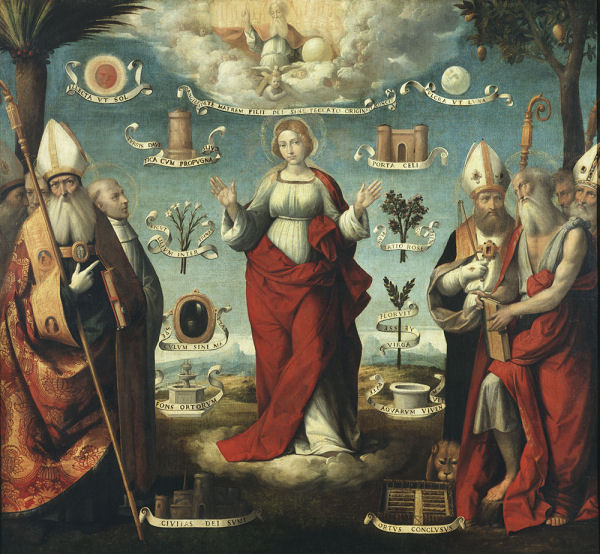
|
|
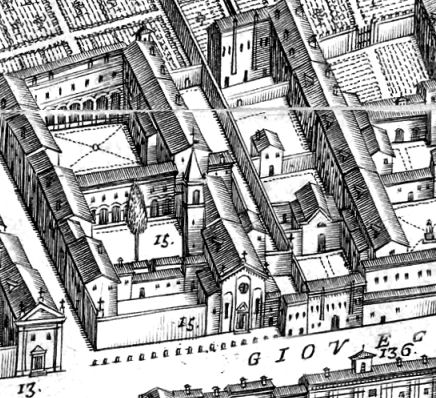
San
Bernardino is number 15
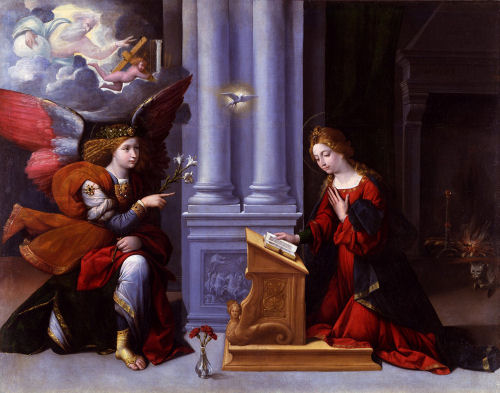 |
|
|
San Gabriele
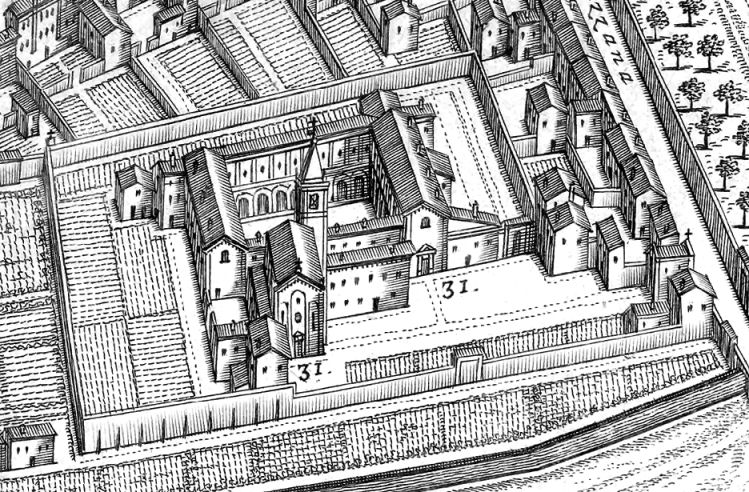
History
West of San Benedetto.
There was a convent here, outside Porta San Biagio, with a hospital,
in the 14th century. It was refounded in 1489 by Duchess Eleonora as
a Carmelite convent. Augustinian nuns being brought from Reggio and
changing their profession. The new church, the building of which
involved Biagio Rossetti, was completed on 15th March 1494. It was
demolished in the 19th century.
San Gabriele is
number 31
|
|
San Guglielmo
Via Palestro |
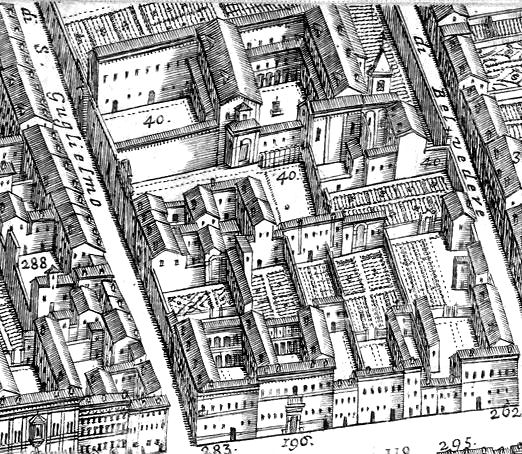
History
A convent given to the Poor Clares in 1256 by Azzo Novello d'Este, having
previously been occupied by Augustinian Eremitani. Tradition claims
it was founded by Agnese, the sister of Saint Clare of Assisi. The church was
consecrated in 1354 and enlarged around
1369 by Nicolò II d'Este when his niece Verde became a nun
here. The high altar was consecrated on 27th April 1489, enshrining
relics of Saint Bartholomew, the apostle, and Saints Stephen and
William. Later major donors were the Costabili family, who also
provided a Mother Superior. Members of the Rinaldi family were
buried here.
Suppressed by Napoleon , the convent was closed in 1798 and became a
barracks, of course. The nuns returned two years later but they left
finally in 1801. Some art went into private collections, some was
destroyed or has disappeared. Fresco fragments (in poor condition)
were found in a room behind the church and removed in 1933, and
others were found and removed in 1954 and 1961 after the partial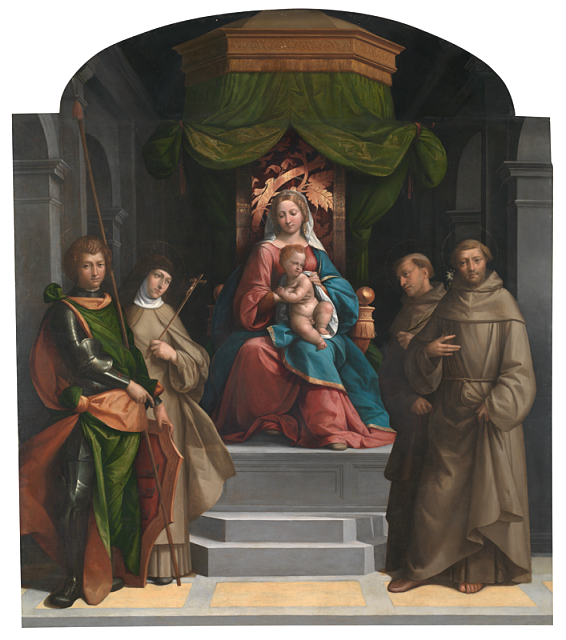 destruction of the complex by bombing during WWII, during the second
bombing, on January 28, 1944, following years of neglect. The former
convent is now a barracks and a car park.
destruction of the complex by bombing during WWII, during the second
bombing, on January 28, 1944, following years of neglect. The former
convent is now a barracks and a car park.
San
Guglielmo is number 40
Lost art
Early 15th-century frescoes of the life of Saint Francis,
saints and scenes from the life of Christ by the school of Antonio Alberti (Antonio de Recchis) were detached in 1933 and, much damaged, are now in the
Casa Romei, in a room to themselves. As is an earlier - mid-14th-century - fresco of
The Agony in the Garden found in a tympanum here and detached in
1961.
An early 16th century fresco fragment on a Crucifixion by a
Bolognese artist is also in the Casa Romei, having been removed in
1954.
An Assumption by Lorenzo Costa from c.1489.
Works in the refectory included one by Cosmè Tura.
A Garofalo Sacra Conversazione panel depicting the Virgin & Child with Saints
William of Aquitaine (Guglielmo in Italian), Clare, Anthony of
Padua and Francis (see right) from 1517 in the National Gallery
was commissioned
for the high altar here by the sisters, helped by Antonio Costabili,
who also commissioned Garofalo and Dosso Dossi to paint the huge
altarpiece mentioned below for the church of Sant'Andrea, where he
was to be buried . It is thought that Guglielmo di Malavalle,
who became a hermit, was probably the original titular saint of this
church as it had been founded by an order of hermits, but Garofalo’s patrons must have supposed that their
Guglielmo was the Duke of Aquitaine, a warrior saint whose legends
and sanctity have recently been contested anyway. The lunette-shape
addition at the top was added in 1861 by Giuseppe Molteni in Milan,
but it replaced an earlier addition, probably itself not original.
A Last Supper on canvas by Scarsellino
from c.1605, painted for the refectory here, is in the Pinacoteca.
|
|
San Lazzaro
|
|
San
Maurelio
Piazza Municipale
|
|
History
Originally an oratory of the Lateran
Canons Regular of Saint Augustine, attached to a plague hospital in
the suburbs, about two miles outside Ferrara, erected in the late
12th century with a joint dedication to God, the Virgin, Saint
George, and Saint Lazarus.
Lost art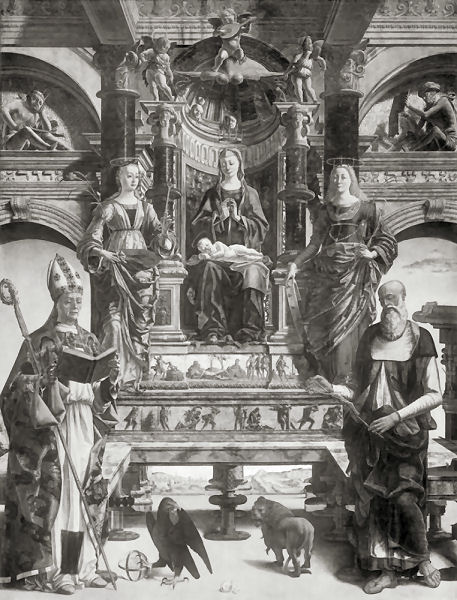
The San Lazzaro altarpiece by Ercole de'Roberti, possibly with
Francesco del Cossa, painted for the renovated presbytery here,
around 1475, was simultaneously Roberti's first important
independent commission and the first unified sacra conversazione
to be painted for a Ferrarese church. It showed the Virgin and Child
enthroned with Saints Apollonia and Catherine of Alexandria in the
upper tier with the Virgin, and Saints Augustine and Jerome at
ground level, with their attributes, an eagle and a lion.
David and Moses inhabited the spandrels and there were Old Testament
scenes in two rows below the throne, featuring the Labours of
Hercules.
The altarpiece was destroyed in May 1945 in the fires in the Friedrichshain flak
tower (Flakturm) where paintings from the the former
Kaiser-Friedrich-Museum were being stored to protect them from
bombing. The Friedrichshain Flakturm was in the custody of the
Russian army at the time. 434 paintings went missing due to unchecked
looting at the time or were destroyed in the flames - there was a
second fire following the two weeks of looting. Only one of the lost
paintings has ever been found - a 16th century Lombard
Virgin and Child was returned to the Gemäldegalerie in Berlin in 2012 by the son of the US officer who had purchased it in
1946.
More here
And here
San Marco
History
Situated within the city walls by the Porta San Marco. Founded by
the Countess Matilda in 1099 and the home of Augustinian canons
until 1476 when Pope Sixtus IV acceded to duke Ercole and the
Duchess Eleanora's request to transfer it to Benedictines. Demolished
by Duke Alfonso in 1506, with permission from Pope Julius II,
possibly for the expansion of the Duke's garden.
|
|
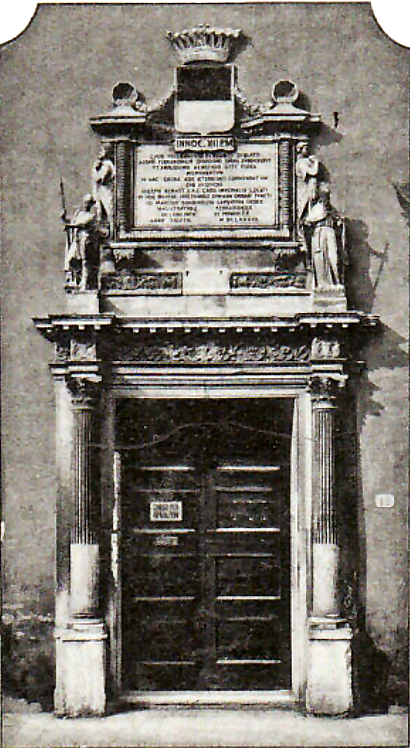
History
Built between 1476 and 1480 for Ercole I d'Este as the court chapel
and as a gift to his wife Eleanor of Aragon. Later work and
enlargement, the church remained important for the Este court, since
their bodies lay there before their burial. It later lost its court
function and in 1693 was dedicated to the 7th century Syrian Saint Maurelius who had long been one of Ferrara's patron saints,
and given to the Unione dei Fratelli delle Anime del Purgatorio, who
remained until 1893 when the church was closed. Later used as a
warehouse, until 1917 when it became a cinema, later becoming the Sala Estense. All that remains
of the church now is the 1693 portale (see right). The statues of
Saints George and Maurelius are by Francesco Vidoni.
Lost art
A grey stone sculpture from 1408 of the Virgin and Child by
Filippo di Domenico da Venezia was removed from the portal here in
1916 and is now in the Casa Romei.
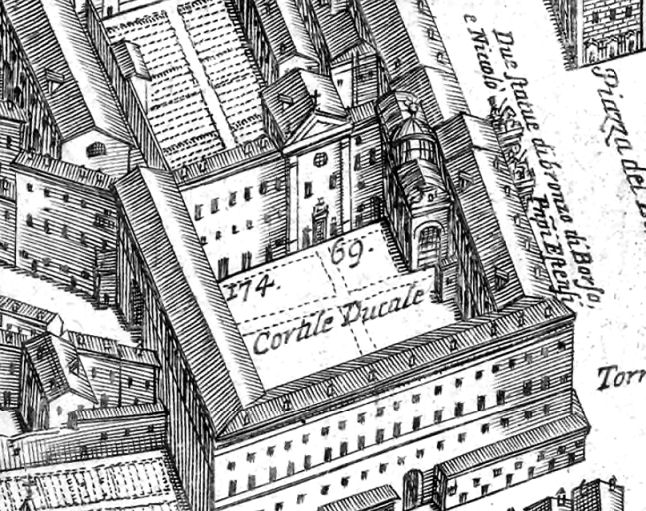
San Maurelio is number 69
|
|
San Silvestro |
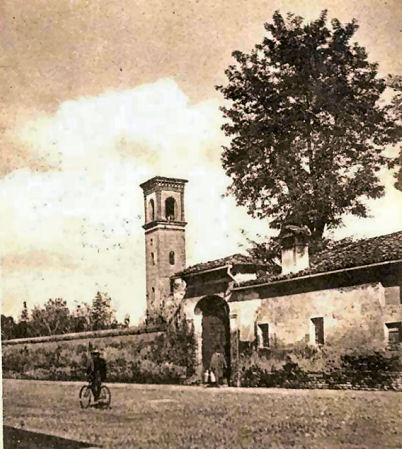 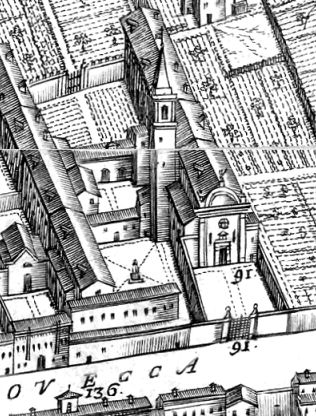
History
A miracle of Saint Mauralius was to restore
the sight of a blind girl, who then retired to pray in a small
building on the site where this church was later built. A Benedictine
church and convent here was completed by 1520, replacing a
complex for these nuns outside the city rebuilt in 1497 by Biagio
Rossetti, which had been demolished by Duke Alfonso I in 1512
to make way for fortifications. An earthquake here in 1570 meant more
rebuilding and fires in 1735 and 1804 caused more damage. The
Benedictine nuns remained until the Napoleonic suppressions in 1796.
In 1799 they returned but the complex was abandoned in 1820 and later mostly demolished. The church survived into the early 20th
century when the city hospital was built here, from 1910. Its main
doorway went to
Santo Stefano in 1825. The
campanile was demolished in 1912.
Lost art
Four grisaille panels of
Stories of Constantine and Sylvester by Garofolo and a large
vertical Agony in
the Garden altarpiece by him from c.1525-30 are in the Pinacoteca. Also a
Virgin and Child with Saints Sylvester, Jerome, John the Baptist and
Maurelio from 1524 by him, which is now in the Duomo. Scarsellino is also
mentioned.
San Silvestro is
number 91
A postcard from 1902
|
|
San Vito |
|
Sant'Agostino |
|
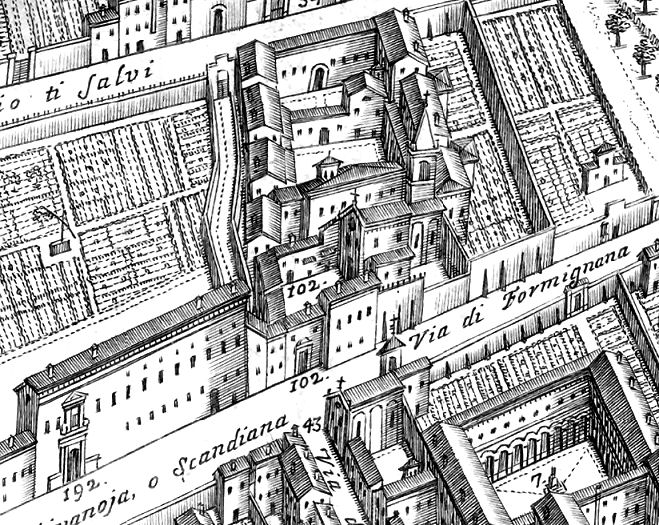
History
A convent for Augustinian nuns dating from
1234 next to the Palazzo Schifanoia. Work on the convent in 1502. Later used
as a barracks and demolished in the 1960s.
Lost art
The Crucifixion with the
Virgin, St. Mary Magdalene, St. John the Evangelist and St. Vitus
of 1522 by Garofolo was painted for this convent. It now lives in
the Brera in Milan, but is currently (May 2024) on display in the
Palazzo Costabili in Ferrara under a very special Garofolo ceiling
San Vito is 102,
the Palazzo Schifanoia is 192, to its left.
|
|
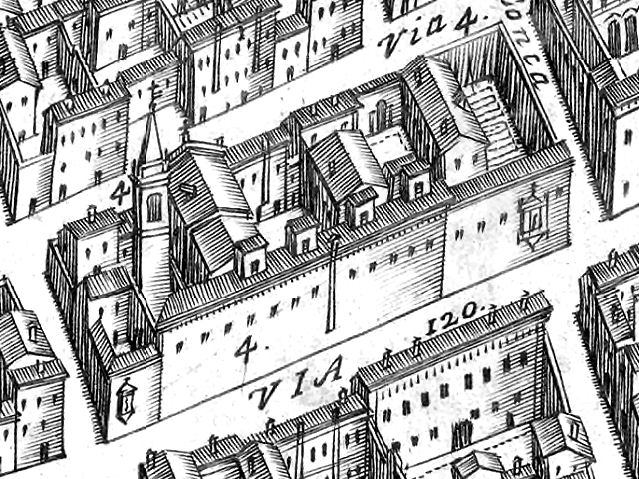
History
Founded as an Augustinian convent for nuns
in 1425 by Alise, daughter of Giovanni di Gallo of Ferrara, and not
to be confused with the later parish church in Corso Roma.
This one was in the parish of Santa Maria in Vado, on the via delle
Volte now the via Coperta. It was consecrated by
the Bishop of Ferrara in 1441 and embellished by Ercole d'Este in 1496.
It was suppressed under Napoleon in 1798 and demolished in 1813.
|
|
Sant'Andrea
Via Camposabbionario |
|
History
Existing by 1070, the church here belonged to the cathedral until
1256 when it passed to the Eremitani order of Augustinians who
enlarged it, with reconsecration by Pope Eugene IV in 1438.
Rebuilding followed from the 1490s (funded by Borso d'Este and the
Duchess Eleonora) and in the 16th century, when the building reached
its final configuration of a nave and two aisles. The aisles
contained nine semicircular chapels each side, while flanking the
apse were two smaller chapels. The chapel of the Blessed Sacrament
was built in 1627 by Giovan Battista Aleotti, and he was buried in
it.
The Augustians were forced to leave
in 1796 by the Napoleonic suppressions, although the church
continued in parish use until 1806. Around 1806 the cloisters were
demolished, following use as a barracks, which use continued into
the late 19th century by Italian soldiers, and then to store
provisions.
In 1886 the church was closed, and the art removed. The roof
collapsed in 1938, after a century of neglect, worse followed with
severe damage from bombing in 1944. Demolition was planned and
following the collapse of the right side the church's remaining
left aisle was demolished from 1965-69 to build the Dante Alighiri
secondary school. A small earthquake in 1967 caused the collapse of
the apse wall and the campanile was subsequently demolished. Ruins
of the right side are all that remain.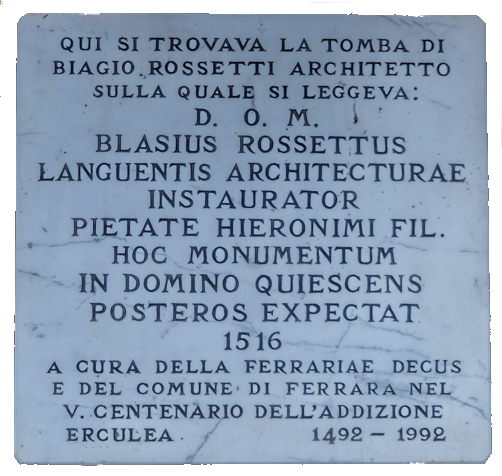
The sad and shameful loss of this so-important
church is hard to forgive, or equal elsewhere.
Buried here
The ducal architect and engineer Biagio Rossetti (at the foot of the
third pillar in the left aisle), A plaque was commissioned in 1993 (see
right). Also Alberto Schiatti (who built San Paolo), Giovan Battista
Aleotti (who built a chapel here), and Giuseppe Mazzuoli (Bastarolo)
the Ferrarese Mannerist painter.
Lost art in
the Pinacoteca
The huge, damaged Allegory of Saint Augustine and The
Martyrdom of Saint Dorothy damaged frescos of c.1378 by Serafino de' Serafini from Modena are in the Pinacoteca.
They were in
the chapel dedicated to Saint Dorothy here, and rediscovered under
plaster in 1871. After poor attempts at restoration, removal and
transfer to canvas they came to the Pinacoteca in 1908. There's also a
detailed
19th-century watercolour by Girolamo Domenichini there, which
shows the loses suffered during the restoration.
Fresco
fragments of Saint Christopher and Saint Sebastian
from c.1450-60 by a Ferrarese master, and follower of Piero della
Francesca, in the Pinacoteca since 1906.
A Saint Andrew panel by Domenico
Panetti from c.1500, from a side altar here dedicated to the saint.
It has what looks like water (rain?) damage along the top. Also four
panels, of Saints Andrew and Augustine and an
Annunciation pair, also by him from 1510 for the organ case.
The Old and New Testament (aka
The Triumph of Christianity over Judaism)
by Garofalo - a large fresco from the refectory here from 1523,
removed in 1841 and acquired by the Pinacoteca in 1846. It was
commissioned by Antonio Costabili (visible in the baptism scene at
bottom left) who also commissioned the famous altarpiece (see
below).
Also
a small panel of The Mass of Saint Nicholas of Tolentino from
a series of the Saint's miracles in the Muzzarelli chapel here, by
Garofalo and in the Pinacoteca since 1846.
The famous and huge high altarpiece The Costabili
Polyptych of 1513 (see right), commissioned by Antonio
Costabili from Dosso Dossi and Garofalo and in the Pinacoteca since
1846. Costabili held communal and ducal office, involving military
and diplomatic activities, during the reigns of Ercole I and Alfonso
I d’Este and acquired patronage rights to the chancel and high altar
here in the 1490s. His family palazzo (later nicknamed Palazzo
Ludovico il Moro) was nearby.
The altarpiece is both a progression from the 15th-century tradition
of Ercole de' Roberti and backward-looking in its multi-panelled
polyptych format, possibly adopted to accentuate its monumentality.
The central panel is a very Bellini-esque Virgin and Child
Enthroned, with the young John the Baptist and Saints, flanked
by panels depicting Saints Sebastian and George, with
Ambrose and Augustine in the Spandrels. The pinnacle
is a Resurrected Christ. The saints in the central sacra
conversazione panel include Andrew on the left and
Jerome on the right with John the Evangelist on the steps
between them. Further back and murky are Joachim and Anna,
the parents of the Virgin, on the right, and Elizabeth and Zachariah,
the parents of John the Baptist, on the left. But these
identifications are contested and a couple more of the saints are
non identificanti.
The Assumption of Mary Magdalene
(the weird one with the large rabbit and the wingless acrobat putti)
by the Master of the Magdalene's Assumption, from c.1505.
A well-muscled Guardian Angel from c.1625 by Carlo Bononi in the
Pinacoteca since 1863.
Saint
Lucy adored by two members of the Sonzoni family by a Ferrarese
master of the early 16th century from the third chapel on the left
here.
Saint Catherine of Alexandria by Giulio Cromer.
The Madonna di Reggio by Camillo Ricci in the
Pinacoteca since 1869
An Annunciation and an Immaculate
Conception and the Glory of Paradise, both by Scarsellino and in
the Pinacoteca since 1869
Lost art in the Casa Romei
A 16th-century marble sculpture of
Saint Nicholas of Tolentino
attributed to Alfonso Lombardi, was originally in a chapel dedicated
to the saint here. A quite camp early 18th century marble San
Michele Arcangelo by Andrea Ferreri and other parts of funeral
monuments.
Nine fragments of anonymous frescoes,
including an Announcing Angel and a Virgin of the
Annunciation from the triumphal arch, from the 13th century, and
four figures of saints and a nun from the apse and nave from the
16th century. Detached 1943-50.
The 1498 monument of Tomasina Gruamonti Estense, the widow of
Azzo X d'Este was originally under the fifth arch on the right in
this church. It is the work of Alvise Lamberti da Montagnana, a
pupil of Mauro Codussi who later worked in Moscow. It was first
moved to the Certosa cemetery and then to the Casa Romei in 1952.
Also a monument to Marquise Lucrezia
Muzzarelli Brusantini, who died in 1679. A marble Archangel
Michael sculpted by Andrea Ferreri between 1720 and 1735.
Lost art elsewhere
The choir stalls, with inlay work attributed to Pier Antonio
degli Abbati, are now in
San Cristoforo alla Certosa.
Memorial slabs were moved to the cloister of Santa Maria
inVado.
Lost art
In 1497 Fino Marsigli was commissioned to fresco the
chancel.
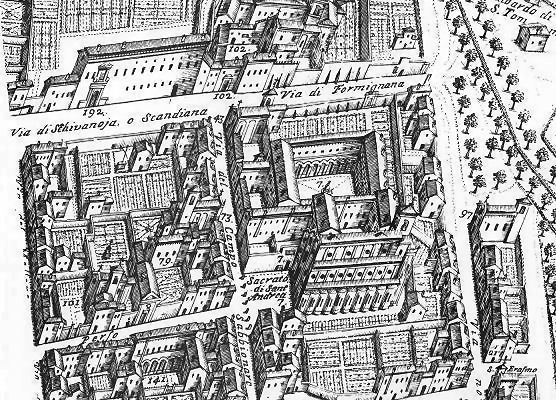
Sant'Andrea is
number 7 middle-right, the Pal Schifanoia 192 top left.
|
|

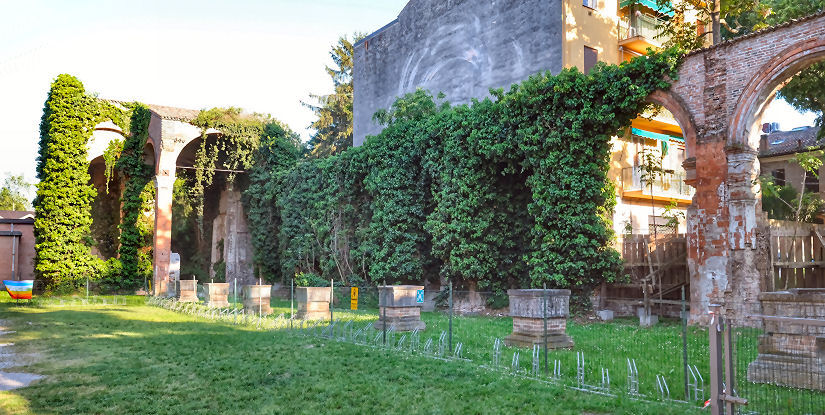
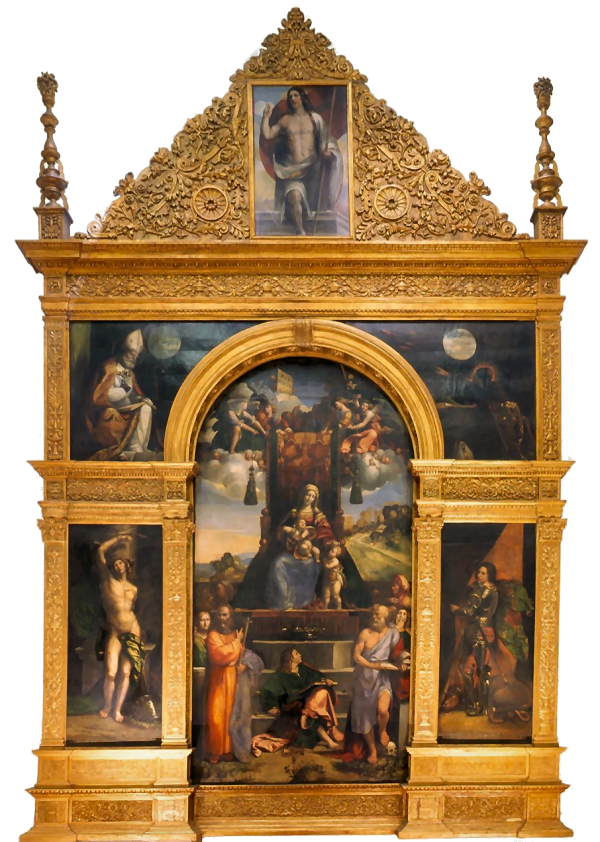
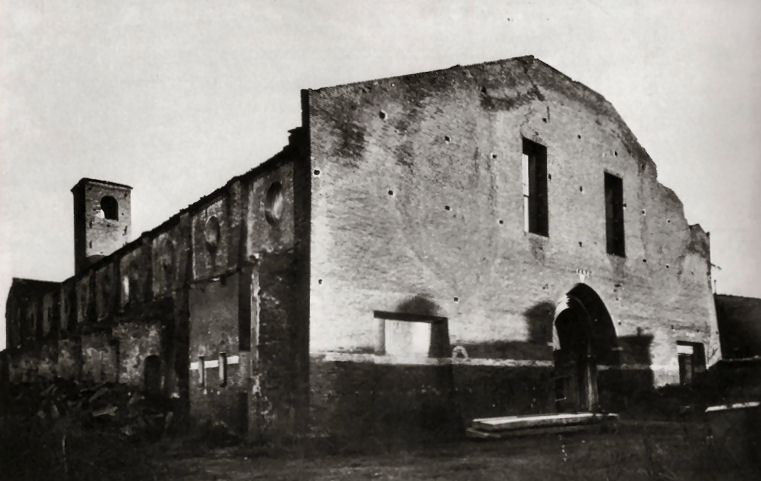
An early 20th century photograph |
|
Sant'Anna |
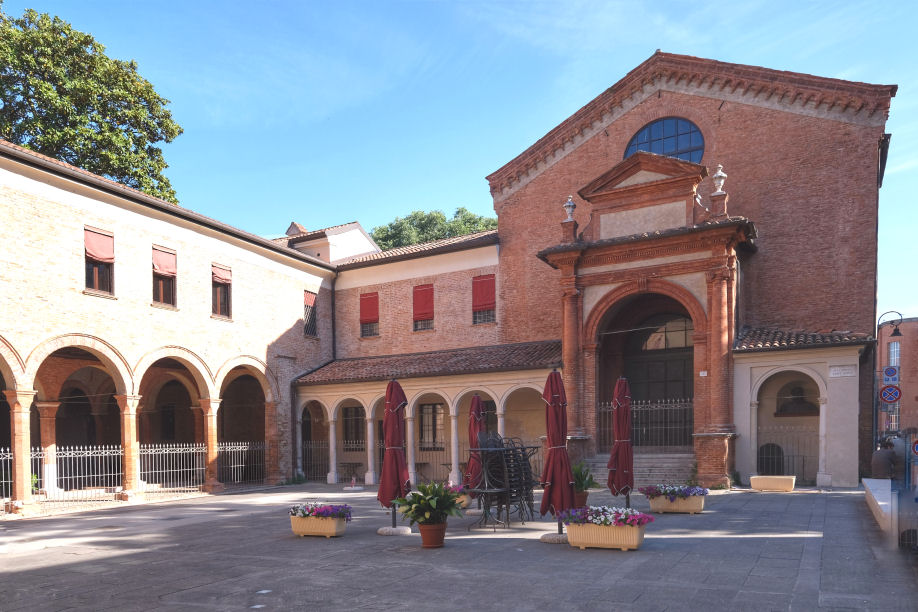
History
The hospital was built in 1445 and remained here until 1930, when
the new hospital was built further up Corso Giovecca. The church was rebuilt
after the earthquake of 1570, was suppressed in 1808 and demolished
in 1824. The hospital is famous for having Torquato Tasso in
residence from 1579 to 1586. The church's portal went to
San Girolamo.
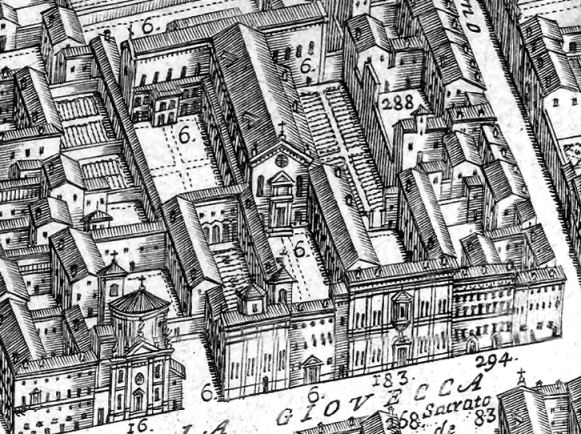
Lost art
A panel now in the Galleria Borghese in Rome depicting Saints
Cosmas and Damian doing dentistry by Dosso Dossi from c.1520-22
was 'presumably' painted for the hospital/church here.
An altarpiece by Bastianino Virgin and Child and Saint Anne in
Glory with Saints Cosmas and Damian from the church here.
|
|
Santa Caterina
da Siena
Via Aria
Nova |
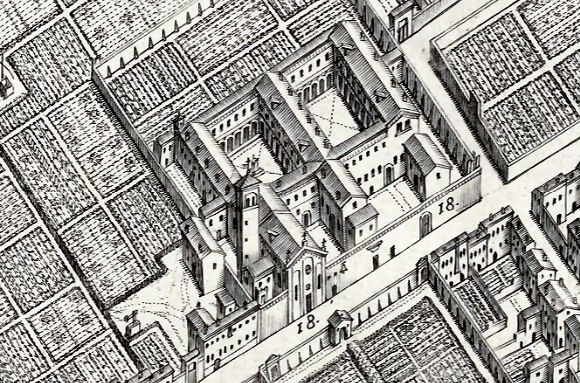 |
|
History
Built by Duke Ercole for Lucia Brocadelli
from Narni who had received the stigmata in 1496, and who Ercole had smuggled,
in a laundry basket, at great expense, out of Viterbo in 1499. This at a
time when nuns were a popular focus of princely devotion in, for example,
Mantua, Milan and Perugia locally. Bandages stained with the blood of her
stigmata were sought by the court of France. She initially stayed at the Casa
Biancha where Santa Maria della Concezione was later built for other nuns from
Viterbo. Duke Ercole laid the first stone for a new convent on 2nd June 1499 and
initially called the Convent of the Sisters of the Annunciation but later, after
Suor Lucia had a vision of Catherine of Siena, was changed to Santa Caterina da
Siena. Built to the west of Santa Maria degli Angeli, the complex was in a fit
state for Suor Lucia and her 22 third-order Dominican sisters to move in on 5th
August 1501, but work continued for at least two more years. Records show this
to be largest and most ambitious of Duke Ercole's religious enterprises. Two
cloisters of two floors housed 46 cells for novices and 95 for the sisters.
118 choir stalls by Bartolomeo da Modena art by Fino - much work, including
frescoes on outside walls and also inside the church with a Passion cycle - and
Ettore Bonacossi. This much painted decoration may have been at Suor Lucia's
request. Suor Lucia fell out of favour after Duke Ercole's death, being accused
of "excessive ascetic harshness" and kept locked in a cell, where she died
39 years later. But a series of frescoes of her life were commissioned after her
death in 1542. Her body was transferred to the cathedral, where it
remained until 1935, when it was moved to the Cathedral of Narni. It has been
said that Suor Lucia da Narni inspired the character of Lucy from the Narnia
novels of CS Lewis. The convent was suppressed by Napoleon in 1796 and
demolished in 1847.
Lost art
A copy of Lorenzo Costa's Strozzi
Altarpiece, which he painted for the oratory of the confraternity of the
Immaculate Conception of the Virgin above the refectory in the church of San
Francesco, was made by Carlo Bononi for this church c.1600-25. It is now in the
Pinacoteca.
|
|
Santa Maria degli Angeli |
|
History
Founded by Niccolò III d'Este for Observant Dominicans in 1437 and
initially named SM di Belfiore after the Este villa nearby. Changed
to SM degli Angeli in 1439 and consecrated in 1440 but the campanile
built later by Borso d'Este. His father had been buried in San
Francesco but Niccolò was buried here in 1441, his son Leonello in
1450, his third wife Rizzarda da Saluzzi in 1474 and then sons
Ercole in 1505 and Sigismondo in 1507.
The church was damaged by Venetian troops during the war of Ferrara
in 1483, who also removed an equestrian statue from from over the
door.
This equestrian image, of painted gesso and cloth on a wooden
framework, of Niccolò III stood in this church by 1447, but was
removed and destroyed during the Venetian sack. It may have been
associated with Niccolò's tomb here, or may have been a votive
offering. It inspired Niccolò's equestrian monument opposite the
Cathedral.
This damage, and the death of his duchess, prompted duke Ercole to
rebuild the Capella Grande and add four adjoining chapels in 1494,
work done by Biagio Rossetti. The creation of the Erculean Addition
was encouraged by how easy it had been for Venetian forces to attack
the edge of the city and sack the Belfiore palace, San Cristoforo
and Santa Maria degli Angeli.
On March 4th 1501, according to Zamboni, Duke Ercole looking for
locations for a larger church saw a comet land in the cemetery of
the old church here and so resolved to build a new church, with the
apse and crossing sited where the comet had landed. He laid the
first stone six days later, on 10th March and the building of the
larger church, unusually with ten chapels radiating from the main
chapel. He would have seen it as a dynastic burial church and other
important families, like the Bentivoglio, exiled from Bologna, were
also buried here. This would have been the largest and most lavish
of Ercole's church buildings, but it was never finished following
Ercole's death and suffered partial collapse during the earthquake
of 1570. The campanile was struck by lightning in 1604 during a
Mass, destroying the high altar and its altarpiece of terracotta
reliefs, and on Easter Sunday 1664 the vault collapsed onto the high
altar. The monastery was suppressed in 1796, became stables,
suffered a fire, and the site was purchased and cleared in 1913. A
handsome building of the early 20th century on the site of the
church, the Palazzina degli Angeli, at the end of the road to the
Certosa, has a commemorative plaque.
|
|
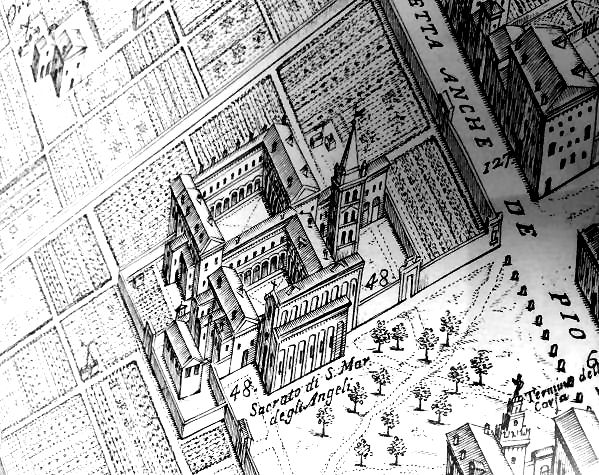 Lost art
Three fragments of an
altarpiece: Saint Mary of Egypt, some Landscape and
Saint Jerome by an early 16th century painter from northern
Italy were in the Mosti chapel here, but are now in the Pinacoteca.
|
|
Santa Maria del Buon Amore
|
|
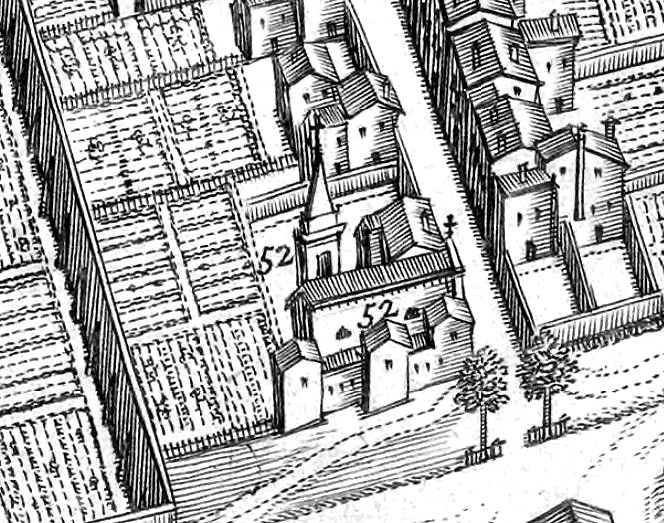 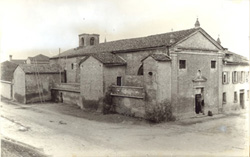
History
Was a few fields east of Sant'Antonio in Polesine.
Also known as the Oratory of the Nativity of the Blessed Virgin of Good Love,
the building was at the end of via Porta d'Amore and dated to the second half of
the 16th century. It was built to preserve an image of the Madonna found
during the construction of the same-named wall. Bastianino, Bastarolo and
Scarsellino contributed. The cult was suspended during the First World War which
led to the demolition of the church in 1924. The area where the building
once stood is now occupied by housing. The cult image went to
Sant'Apollonia
up the road.
|
|
Santa Maria della Concezione
|
|
|
|
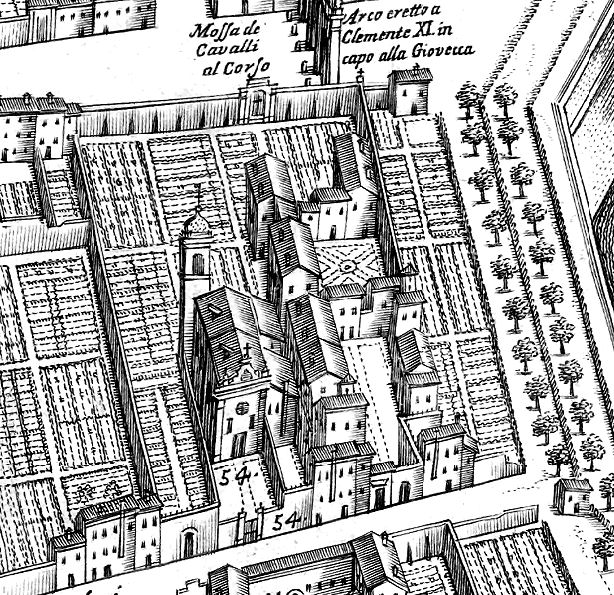
History
An oratory dedicated to the Immaculate
Conception, called Santa Maria della Casa Bianca, had stood here since
1466, at the wall end of what is now via Cisterna del Follo. When Suor Lucia da Narni was brought to Ferrara (see
Santa Caterina da Siena
above) on May 7 1499 she stayed here for a few weeks and Duke Ercole
ordered some work in preparation. He then decided to build a new
convent here, entrusting the work to Antenore da Bondeno and laying
the first stone himself on May 30 1502. A new church was built here
by Ercole II but neither church nor convent survive. by
Lost art
Fragments of frescoes by
Baldassarre Estense, Nicolo Pisano and (maybe) Michele Coltellini, from
c.1499/1501 are in the Pinacoteca.
|
|
Santa Maria della Rosa |
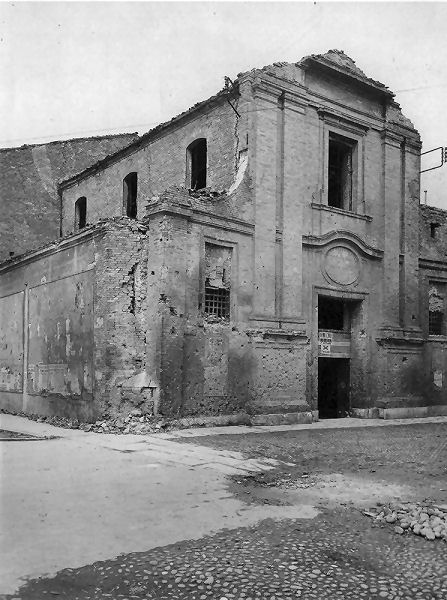 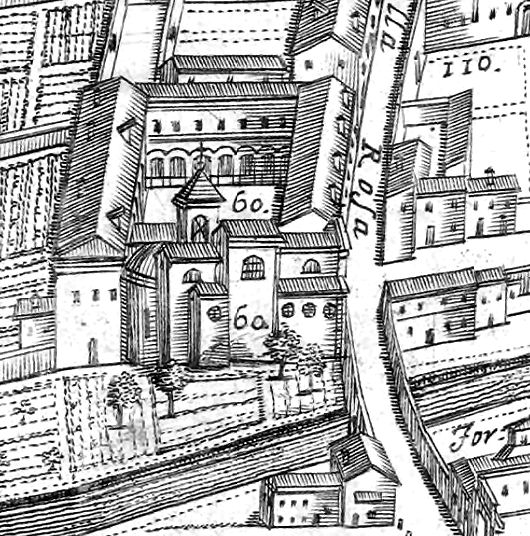
History
The name comes from roxa, a word for a canal. There was a small church called Santa Maria
del Guazzadore, with a hospital attached, outside the city walls, on the left
after leaving by the Porta de' Leoni. It was so named for a nearby shallow
watering place for horses and such. In 1466 the complex was occupied by
Augustinians who had been living in Santa Maria della Misericordia outside Porta
San Giorgio. They were described by Giovanni Battista Guarini (the writer of
Il pastor fido) in his 1621 book about the churches of Ferrara as 'Ermitani
of the Congregation of the Peter of Pisa, observants of the rule of Saint
Jerome, now called amongst us as of the Rose'. Work by Duke Ercole involving the
roofing and flooring of the crossing and the building of three chapels. Rebuilt
in the early 17th century, bombed in September 1944 (see left) and demolished in 1950. Part of an earlier cloister was reconstructed, however,
and can be seen on the north side of via Cavour, the road which replaced the
canal in the map view below. which fed the Castello's moat, just to the
right out of frame.
Lost art
The Lamentation group of
polychromed terracotta statues by Guido Mazzoni was originally here
(see 1901 postcard below), from 1485 until it was moved to the
Gesù in 1938.
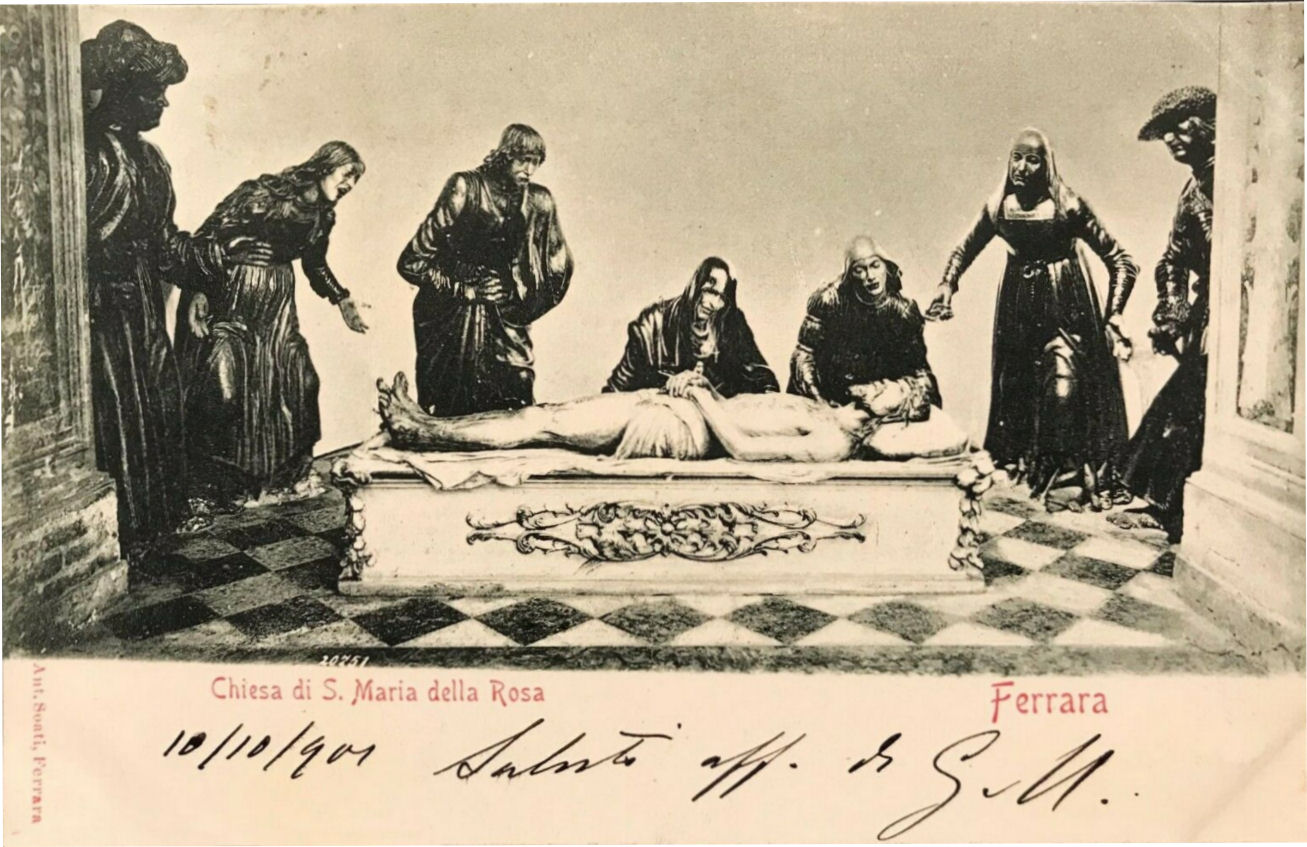 |
|
Spirito Santo
History
Not to be confused with Santo Spirito.
Built between 1616 and 1625 then
deconsecrated and used as a warehouse. In 1839 its portal was put on the
façade of Sant'Apollonia.
|
|
|

 destruction of the complex by bombing during WWII, during the second
bombing, on January 28, 1944, following years of neglect. The former
convent is now a barracks and a car park.
destruction of the complex by bombing during WWII, during the second
bombing, on January 28, 1944, following years of neglect. The former
convent is now a barracks and a car park.






